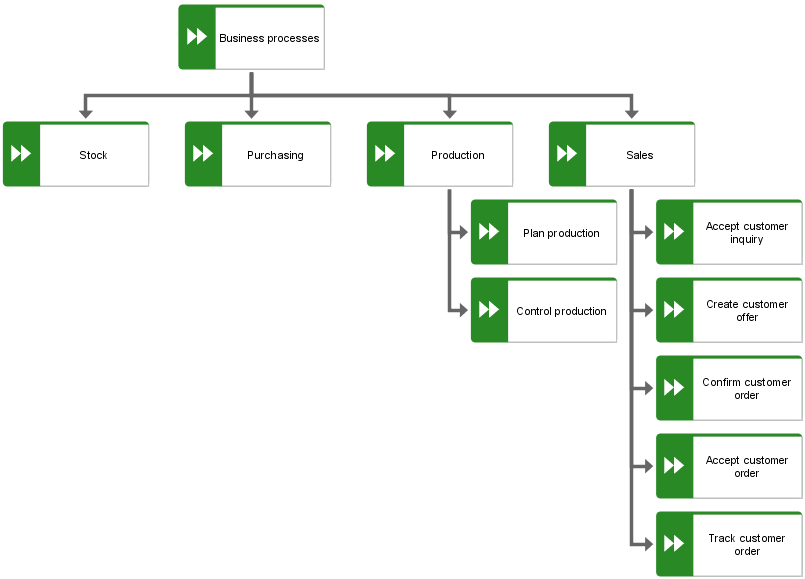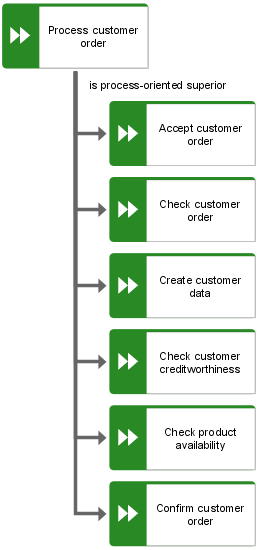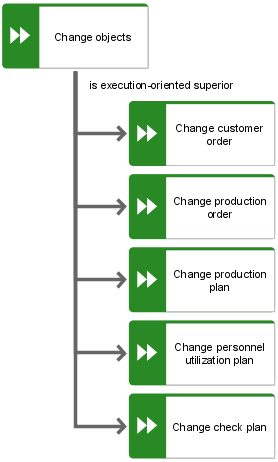Function tree
Functions can be described at different aggregation levels. Accumulations of functions in the form of business processes or process chains form the top level of aggregation. An example may be the processing of a customer order, from customer inquiry through to shipping. A business process thus represents a complex function that can be broken down into subfunctions to reduce its complexity. The term 'function' can be used at all hierarchy levels. However, other terms, such as procedure, process, subfunction, or elementary function, are also used to indicate the hierarchy level.
Breaking down functions can be done across multiple hierarchy levels. Elementary functions represent the lowest level in semantic function trees.
Elementary functions are functions that, from the business management point of view, cannot be broken down any further.
Hierarchical structures are best represented using function trees or hierarchy models.
Grouping functions within a function tree can be performed according to different criteria (see Brombacher/Bungert, 'Praxis der Unternehmensmodellierung' [Enterprise modeling practise], 1992). Criteria frequently used for this purpose include: processing of the same object (object-oriented), breakdown according to process affiliation (process-oriented), or grouping of functions in charge of the same operations (execution-oriented).
The next figure shows an example of an object-oriented breakdown. The superior Process production order function is subdivided into the functions Create production order, Confirm production order, Update production order, Cancel production order, Release production order and Monitor production order. These functions describe different operations (create, update, cancel, etc.) that are performed for one and the same object, which is Production order.
A process-oriented representation is recommended for function trees that represent the results of business process modeling. The following figure shows an example of process-oriented function breakdown.
The functions Accept customer order, Check customer order, Create customer data, Check customer creditworthiness, Check product availability, and Confirm customer order are part of the Process customer order business process. Unlike the object-oriented breakdown, the operations here are performed for different objects (customer order, product availability, etc.).
Execution-oriented grouping means that all functions performing the same operation (check, create, delete) for different information objects are grouped together. An example of the Change operation is shown in the following figure. The functions shown may occur in different processes and are involved in processing different objects. However, the type of operation they perform for the various objects is always the same.
Representing functions in a function tree reduces complexity, but the representation is static. Besides the static representation, the chronological sequence of functions may also be of interest. Chronological-logical operational sequences are represented in so-called event-driven process chains (EPCs). These contain not only functions, but also events linking the functions. Events belong to the data view in ARIS. In line with the principle of separation of views stipulated by ARIS (see chapter
Requirements definition), event-driven process chains are described in the ARIS control view.
Describing functions from a requirements definition-related point of view involves not only the principle of breaking down functions into subfunctions, but also other function properties, especially those that can influence the design of business processes.
For example, it is recommended that functions always include information on whether or not user intervention is required for carrying out the function. Functions of similar type that can be carried out automatically may be bundled and processed in a batch run.
Information on the quantity structure of a function (e.g., number of inquiries processed in a day) and on the total amount of time it takes to carry out the function provide further data that can serve as a basis for decision-making with regard to the redesign of business processes. The total amount of time can be further divided into individual units of time (orientation time, processing time, wait time). In ARIS, this information can be saved in the attributes of the Function object type. A list of all attribute types that are available is provided in the ARIS Method – Tables manual (ARIS Method tables.pdf) on your installation media.




